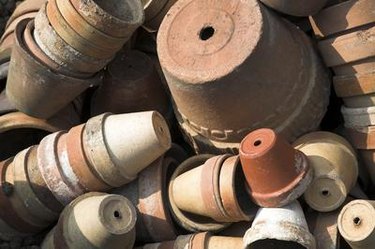
The holes in the bottom of most flower pots and plant containers provide a necessary function; they allow excess water to drain freely from the soil after you water the plants. Not all pots come with drainage holes, which necessitates creating a drainage method for the pot before you begin to grow a plant in it.
Drainage Concerns
Video of the Day
Too much water trapped in the soil causes the plant roots to suffocate, which eventually leads to root rot and death. Suffocating roots cannot absorb oxygen and nutrients from the soil. Waterlogged conditions may also favor the growth of mildews and other fungus problems.
Video of the Day
Without drainage, excess moisture can't escape the pot so it becomes trapped in the soil. Even if the top of the soil feels dry in an pot without drainage holes, moisture trapped in the bottom of the pot can still cause rot issues.
Making Drainage Holes
Pots require drainage holes in the bottom or around the side near the bottom edge. Creating holes in plastic, resin and wooden containers involves nothing more than a drill and the appropriate-sized bit.
Drill one to four three-quarter inch holes in the bottom of the pot to provide ample drainage for the soil. Add a drip tray to catch the excess eater as it seeps through the soil.
Double Potting
Clay and cement pots are more difficult to drill without a special bit. The pots may crack even if you use the correct bit. Double potting provides an alternative to drainage holes. Plants grow in a plain plastic pot or liner equipped with the necessary drainage holes, then are they are set inside a decorative pot that lacks drainage holes.
Water that drains from the liner collects inside the larger outer pot, which can cause soggy soil if the plant is left to sit in the water. Place a 2-inch layer of gravel inside the larger pot to elevates the liner so it rests above any drained water. Drain the excess water from the outer pot after you water the plant to prevent soggy soil.
Drainage Issues
Plants that are grown in pots with drainage holes aren't immune to problems caused by poor drainage. Attached drip trays collect moisture between the bottom of the pot and the tray, effectively negating any benefits provided by the drainage holes. Turn the pot on its side to empty this collected moisture so it is not reabsorbed into the soil through the drainage holes.
Decorative foil wrapping, such as that placed around the pots of holiday plants, also traps water even if the pot has drainage holes. Always remove the foil to keep your plant healthy.